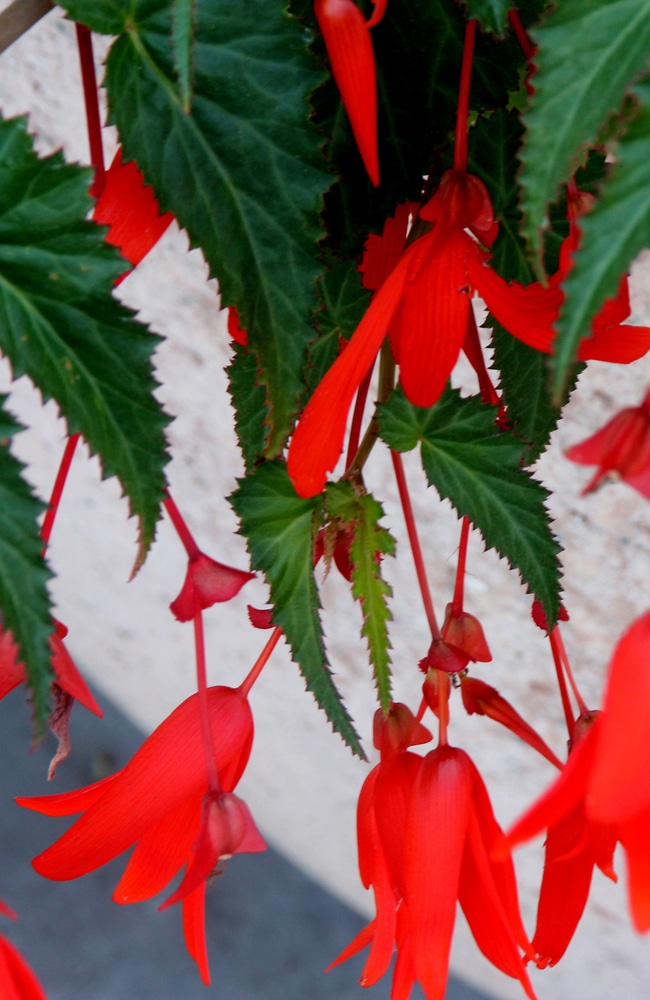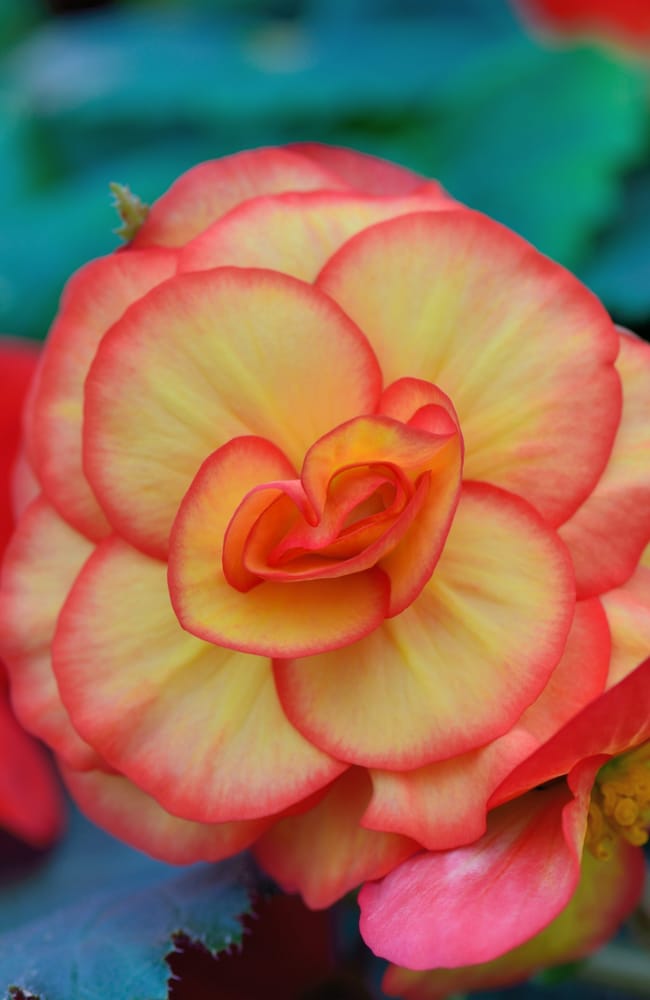Do you know that begonias have been in many Top 10 Favorite Plant lists for many years? And for good reason!
Although some people might think that they are fusty old plants that Grandmother grew, their gorgeous foliage, huge ever-blooming flowers, and easy care make them popular plants. It’s compact, bushy structure with fleshy stems, bronze leaves, and flowers in shades of white, pink, or red make it a sight to behold.
If you are looking for other flowering plants to grow, check out how to raise black-eyed susans. They will add vibrant colors to your garden.
We predict that when succulents are “out,” begonias will be the new stars.
Begoniaceae consists of 1500 plant species native to the tropic and subtropic areas of both the eastern and western hemispheres.
They are hardy perennials in horticultural zones 10 and 11, where some types can reach heights of 10 feet! In colder zones, they are grown as summer annuals. They are also grown as houseplants for their beautiful leaf patterns.

How Many Types Are There?
Begonia species have been cultivated for centuries. Today there are over 10,000 hybrids.
Obviously, we can’t discuss all the many types here, but let’s look at some of the most outstanding varieties and ways to use them in your garden and your home. You’re sure to find one that’s perfect for you.

Horticulturists divide begonias into groups based on their roots: fibrous, rhizomatous, and tuberous.
Fibrous roots branch out in all directions and are often threadlike.
Rhizomatous roots send out runners just under or along the soil.
Tuberous roots are thick and fleshy – potatoes are tubers.
Being able to identify the root system becomes helpful in identify the particular species and also determining the best use and its proper care. Begonias’ root structures can also help determine the appropriate propagation method for your plant.
How Do I Tell What Kind I Have?
With thousands of varieties, identification can be difficult, but it’s not impossible.
First, look at the roots to determine if they are tuberous, fibrous, or rhizomatous.
Consider the growth habit of your plant. Is it upright, mounding, or trailing?
Next, look at the stems. Jointed stems indicate you have a cane type; an absence of branching indicates a shrub type.
The leaves are the next identifier. If your plant has beautifully patterned leaves, it is most likely a rex begonia. An obliquely shaped leaf that looks like a wing indicates an angel wing or dragon wing begonia. Green or bronze oval leaves let you know you have a wax begonia.
Finally, look at the flowers. An absence of flowers, or small insignificant flowers, tell you it’s probably a rex or shrub type. Lots of big, beautiful blooms are hallmarks of tuberous and hiemalis begonias.

Read (and look at the pictures) of the most popular types below, which can help you identify your particular species. The American Begonia Society’s website also has many articles describing different types, which can help you figure out which one you have. Gardening catalogs or an online image search can also help you determine the type that you have.
Fibrous Types
Fibrous begonias are great for growing in gardens. They can take a little more sun exposure than other types, and they aren’t overly picky about water as long as they are kept moderately moist.
They are more adaptable to a variety of growing conditions than some of the other types, and that’s a big part of their appeal.
Wax Begonias
Scientific Name: Begonia x semperflorens-cultorum
Size: Very uniform plants that are 6 to 8 inches tall.
Flower Colors: Red, pink, rose pink, and white.
Characteristics: Wax begonias have waxy, glossy, oval leaves that are green or bronze. Their flowers are produced in a cluster and bloom continuously from first to last frost. The Cocktail and Super Olympia varieties have been garden favorites for decades.
Design ideas: Wax begonias make excellent bedding plants. Their uniform habit and continuous flowering make them strong performers in garden beds or containers. Plant them with black mondo grass, carex, caladiums, or ferns. Or tuck them in around shade-loving perennials like hosta and heuchera.

Angel Wing
Scientific Name: Begonia ‘Angel Wings’
Size: About 10 to 20 inches tall, but some types can be taller.
Flower Colors: red, pink, white, bicolor.
Characteristics: These types are also known as cane begonias due to their jointed stems that look like bamboo canes. Angel Wing, Baby Wing, and Dragon Wing have similar growth habits and flower clusters, but Angel Wing have spots on the leaves, while Dragon Wings do not.
Design Ideas: Their arching stems make cane begonias perfect for a hanging basket of a front porch container. As bedding plants, they can cover a large area quickly – some of these can grow to five or six feet tall!

Whopper Begonias
Scientific Name: Begonia x benariensis
Size: 34 inches high by 22 inches wide
Flower Colors: Red and rose
Characteristics: Large arching stems and profuse flowering over green or bronze leaves make this variety a showstopper. ‘Big’ is a similar variety but slightly smaller. This plant can take sun or shade and is adaptable to cool or hot temperatures.
Design Ideas: Excellent in garden beds and large planters, and perfect for mass planting. If used in window boxes, you might not be able to see out the window!

Rhizomatous Types
Rhizomatous types are grown for their beautifully patterned leaves. Sometimes referred to as foliage begonias, their leaves are patterned with multicolor swirls and splashes. The flowers are often insignificant.
Most commonly grown as houseplants, rhizomatous types can also make a statement in a shady garden area or as part of a container arrangement. This type requires less water and fertilizer than other types and is often slow-growing.
Shrub-like Begonias
Scientific Name: Begonia metallica, luxurians, and others
Size: Varies – some varieties are miniatures, others are measured in feet!
Flower colors: The flowers are insignificant; this plant is grown for its leaves.
Characteristics: Shrub-types grow like any typical, with many stems growing up from the soil. The stems do not branch as other types do.
Design ideas: Use the larger types as backdrops to a shady foliage bed. They will work well with impatiens, hosta, and ferns. The smaller types work well in pots and planters either as the star or in a supporting role.

Rex Begonias
Scientific Name: Begonia rex-cultorum
Size: Most varieties are 12 to 18 inches tall.
Flower color: Flowers are insignificant. Leaves are colored in green, red, silver, and purple.
Characteristics: Rex types, also known as fancy leaf, have vibrant patterns of color on their leaves. Leaves can be ruffled, swirled, or fringed depending on the variety.
Design ideas: This is the gorgeous houseplant your grandmother has on her windowsill! Rexes are stunning in the indoor garden or a terrarium, but some can also be used as a statement plant outdoors.

Tuberous Types
These types are grown for their beautiful flowers and are big performers in semi-shady gardens. A tuberous begonia likes a little more shade, a little less heat, and a little less water than other types.
They can be overwintered – simply lift the tubers, shake off the soil, and store in a cool, dry place until planting time in spring.
Non-Stop Begonias
Scientific Name: Begonia x tuberhybrida Non-Stop
Size: 8 to 10 inches high
Flower Colors: red, orange, pink, yellow, rose, white, white with rose pink.
Characteristics: Double and semi-double large continuous blooms on branching plants with a mounding habit. Flowers range in size from 2 to 5 inches.
Design Ideas: Plant upright forms in the shade garden. The mounding forms are great in baskets and pots. Non-Stop Mocha has bronze leaves; On Top is a variety that has picotee flowers.

Picotee Begonias
Scientific Name: Begonia x tuberosa
Size: 14 to 20 inches high, 10 to 12 inches wide
Flower Colors: Pink, red, orange, yellow, apricot, edged in white or a contrasting color.
Characteristics: Picotee creates a blossom that is one basic color with petals edged by another color. These plants have 4 to 5-inch flowers with double or semi-double petals.
Design Ideas: This type is another stand-alone plant! The flowering habit of picotees demands that they be planted in an area where they can be seen close up. They shine in porch pots and window boxes; plant them in shades that compliment your home.

Bolivian Begonias
Scientific Name: Begonia boliviensis
Size: 8 to 16 inches high, 8 to 20 inches wide, depending on the variety.
Flower Colors: Orange, pink, red, white, and yellow.
Characteristics: This type is a trailing form that is very dense with lots of branching stems. The flowers grow at the ends of each stem and entirely cover the plant.
Design Ideas: This is the best species for hanging baskets and in containers. Encanto is a smaller variety, but the blooms are just as gorgeous as the larger Bossa Nova series.

Roseform Begonias
Scientific Name: Begonia x tuberhybrida Roseform
Size: 14 to 20 inches high, 10 to 12 inches wide.
Flower Colors: pink, red, salmon, yellow, apricot, orange, and rose.
Characteristics: Boasting blooms that look like roses measuring up to 6 inches across, Roseforms have the world’s biggest flowers and are standouts anywhere in part to full shade.
Design Ideas: Use the AmeriHybrid varieties in planters and beds. The Illumination series has a trailing habit that is excellent for hanging baskets. Plant these beauties on their own or mix a few coordinating or contrasting colors in one pot. These divas are too lovely to share the spotlight!

Hiemalis begonias
Common Name: Rieger or Elatior
Scientific Name: Begonia x hiemalis
Size: 8 to 12 inches high.
Flower colors: Double flowered in shades of orange, red, yellow, peach, pinks, and bicolors.
Characteristics: Hiemalis are a cross between wax and tuberous types. Bred to bloom in winter, plants in this group are often sold as houseplants, but they have their place in the garden as well.
Design ideas: These types would be perfect for growing as winter annuals in areas with mild winters since they don’t like temperatures about 80°F. Their mounding and trailing growth habits lend themselves to use in pots and hanging baskets.

Care Guide
Some people might think that begonias are hard to grow, but if you meet their water, sun, and fertilizer conditions, you will find that they are pretty easy going.
Partial Sun
When grown outdoors, they prefer a shady location out of the midday sun. They will grow best with morning sun and afternoon shade. They like well-draining soil; in containers and hanging baskets, use a soilless potting mix.
Indoors, they like bright, indirect light. A north or east-facing window offers the best sun exposure.
Watering Frequency
Indoors and out, water when the top of the soil is dry. While they grow well in moist soil, they don’t like to be constantly wet.
Take care not to get water on the leaves, especially with indoor plants. This can cause the foliage to rot.
Fertilization
Fertilize every other week with a balanced liquid fertilizer. Houseplants stop growing in late autumn, so don’t fertilize when caring for them in the winter.

Do They Come Back Every Year?
Only in zones 10 and 11.
Begonias are tropical plants and cannot survive temperatures below freezing. In colder climates (zones 3 to 9) they are grown as annuals.
Tuberous types can be lifted and stored in a dry cool place for planting the next spring. Be careful not to nick or damage the tubers when you lift them as that can cause rot.
Which Types Take Full Sun?
Wax begonias, especially the bronze leaf varieties, can take full sun.
Angel wings and landscape begonias like Whopper are also tolerant of full sun conditions. However, they will perform their best if given an eastern exposure and a break from the hot sun in the afternoon.
Begonias in full sun will need more water than their shade dwelling counterparts.

